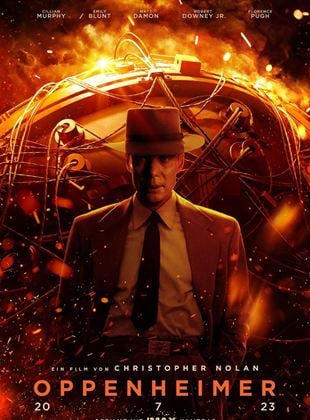![]()
USA | UK 2023
Opening July 20, 2023
Directed by: Christopher Nolan
Writing credits: Christopher Nolan, Kai Bird, Martin Sherwin
Principal actors: Cillian Murphy, Emily Blunt, Matt Damon, Robert Downey Jr., Florence Pugh
 The audience won’t feel untouched after sitting through director-writer Christopher Nolan’s epic three-hour film. At first, it’s confusing to figure out who is who (so many physicists in one film), which time period is involved (lots of flashbacks), and the significance of the black-and-white footage. As the movie progresses that all becomes clear, or irrelevant. Upon leaving the theater, historic and scientific facts infused with questions of morality intrude, bubble, and swirl. Upon leaving the theater the human heart is a bit heavier as if bearing even just a molecule of the burden J. Robert Oppenheimer, “the father of the atomic bomb” was shouldering.
The audience won’t feel untouched after sitting through director-writer Christopher Nolan’s epic three-hour film. At first, it’s confusing to figure out who is who (so many physicists in one film), which time period is involved (lots of flashbacks), and the significance of the black-and-white footage. As the movie progresses that all becomes clear, or irrelevant. Upon leaving the theater, historic and scientific facts infused with questions of morality intrude, bubble, and swirl. Upon leaving the theater the human heart is a bit heavier as if bearing even just a molecule of the burden J. Robert Oppenheimer, “the father of the atomic bomb” was shouldering.
A gaunt Cillian Murphy brilliantly embodies J. Robert Oppenheimer, the scientist who oversaw the development of the atomic bomb during WWII. There is a glimpse into his early life, and flashbacks of his neurotic student days and later academic life surrounded by intellectuals and renowned physicists. He falls in love with the political firebrand Jean (a magnificent Florence Pugh) and never quite gets over her. In 1942, he is approached at Berkeley by Lieutenant General Leslie Groves (a spot-on Matt Damon) to oversee the management of a clandestine government laboratory to be set up to develop the atomic bomb under the code-named The Manhattan Project. Oppenheimer’s resume isn’t ideal. He is a theoretical physicist not an experimental one, he has had no administrative experience, and he is said to run in leftist social circles. His wife Kitty (a seductive, feisty Emily Blunt), like his lover Jean, is rumored to have been a communist. Still, Groves is convinced Oppenheimer is his man and eventually agrees to his vision of building a town of more than 6,000 in Los Alamos and setting up the laboratory there in this remote area of New Mexico. They recruit the best and brightest scientists to bring their families to this centralized location to accelerate the building of the bomb. They are in an existential race against the Nazis building the bomb first.
Based on the book American Prometheus: The Triumph and Tragedy of J. Robert Oppenheimer by Kai Bird and Martin J. Sherwin, Oppenheimer is depicted as a complex and conflicted genius who always understood what “success” would mean for mankind. Most of the film is subtly shown from his perspective, behind his melancholy, piercing blue eyes. Intermittently a parallel storyline emerges, the more objective almost newsreel black-and-white segments many featuring his archrival Lewis Strauss (a superbly sinister and unrecognizable Robert Downey Jr.). Strauss headed the Atomic Energy Commission (AEC) in the 1950s and is convinced Oppenheimer, who had strong reservations about developing an H bomb, is not to be trusted. Though not regretting his role, over the years Oppenheimer had transformed from being the creator of nuclear weapons to being the alarmist about the dangers of nuclear war. Truman had called him a “crybaby” when he said, “I feel we have blood on our hands” when visiting him in the Oval Office. Strauss spearheads closed hearings before the AEC to have Oppenheimer stripped of his security clearance. This is a humbling blow for “the father of the atomic bomb” who had been heralded as the ultimate American hero following the war.
For technical film buffs it is interesting to note Nolan relied on practical effects and analog methods rather than CGI technology. Also, it is filmed in a combination of IMAX 65mm and 65mm large-format film—including IMAX black-and-white analog photography. So it’s best to watch it in an IMAX theater, if possible.
Ludwig Göransson’s score including the engagement of 40 violinists is dramatic, strident, intense, and ever-present mirroring the inner tension of the main character Oppenheimer and the historic events unfolding. Which made the one moment there no music exceptional: the moment the first atomic bomb was tested in the New Mexican desert there was DEAD silence.
Nolan also has enlisted a massive ensemble which includes Tom Conti as Albert Einstein, Gary Oldman as Harry Truman, Kenneth Branagh as Danish physicist Niels Bohr, Casey Affleck as military intelligence officer Boris Pash, Josh Hartnett as physicist Ernest Lawrence, Rami Malek as physicist David Hill, and for his German fans Matthias Schweighöfer as German physicist Werner Heisenberg. However, at times, they seem like cardboard figures placed there just to shine a spotlight on Cillian Murphy and Robert Downey Jr. who play the roles of their lifetimes.
Nolan shows no footage of the two bombs dropped on Hiroshima and Nagasaki. There are no scenes of the devastation and destruction they caused. Yet, during a press conference right after the bombing, Oppenheimer has a horrific vision watching a young woman (Flora Nolan, daughter of the director) in the audience and seeing her face melting off. That’s as gruesome as it gets, and yet, there is a smothering feeling of terror and doom enveloping the entire film. As Oppenheimer thought when watching the mushroom cloud during the first test in the desert, “Now I am become death, the destroyer of worlds.” )
